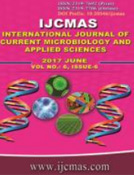Genetic Variability, Heritability and Genetic Advance in Carrot (Daucus carota var. sativa L.)
Suresh Kumar Teli*, R.A. Kaushik, K.D. Ameta, Vikram Kumar Kapuriya, Dalulal Mali and Lokesh Kumar Teli
Department of Horticulture, Rajasthan College of Agriculture,
MPUA&T, Udaipur (Rajasthan) 313001, India
*Corresponding author
Abstract:
The present investigation was carried out to study the variability, heritability and genetic gain for different characters of carrot. The experimental material comprised of thirty genotypes of carrot and laid out in randomized block design with three replications during rabi season of 2015-16 at the Horticulture Farm, Rajasthan College of Agriculture, Udaipur. Observations were recorded on fourteen economic characters. Visual observations were also taken to characterize the genotypes. Analysis of variance revealed highly significant differences among the genotypes for all the characters. The genotypes RAJC-11, RAJC-7 and HRC-1 were the best with respect to highest total yield per hectare. The magnitude of the phenotypic coefficient of variation (PCV) was higher than corresponding genotypic coefficient of variation (GCV) for all the characters which indicated role of environment on the character expression. Carotene content, root weight per plant, root shoot ratio, yield per hectare and fresh weight per plant possessed higher values of GCV, heritability and genetic gain. These are the most important traits for applying selection in carrot for crop improvement.
Keywords: Genetic variability, Heritability, Genetic advance, Carrot, Yield
Download this article as 
How to cite this article:
Suresh Kumar Teli, R. A. Kaushik, K. D. Ameta, Vikram Kumar Kapuriya, Dalulal Mali and Lokesh Kumar Teli. 2017. Genetic Variability, Heritability and Genetic Advance In Carrot (
Daucus carota Var. Sativa L.).
Int.J.Curr.Microbiol.App.Sci. 6(5): 2336-2342. doi:
https://doi.org/10.20546/ijcmas.2017.605.261
 Citations
Citations



 National Academy of Agricultural Sciences (NAAS)
National Academy of Agricultural Sciences (NAAS)





